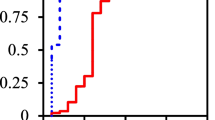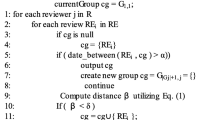Abstract
During the online shopping process, customer reviews strongly influence consumers’ buying behaviour. Fake reviews are increasingly utilized to manipulate products’ reputations. Automatically and effectively identifying fake reviews has become a salient issue. This study proposes a novel individual-group-merchant relation model to automatically identify fake reviews on e-commerce platforms, which focuses on the behavioural characteristics of the stakeholders. Three groups of indicators are proposed, i.e., individual indicators, group indicators and merchant indicators. An unsupervised matrix iteration algorithm is utilized to calculate the fake degree values at individual, group and merchant levels. To validate the model, an empirical study of fake review identification on a Chinese e-commerce platform is implemented. A total of 97,804 reviews related to 93 online stores and 9558 different reviewers are randomly selected as the test data. The experimental results show that the F-measure values of the proposed method in identifying fake reviewers, online merchants and groups with reputation manipulation are 82.62%, 59.26% and 95.12%, respectively. The proposed method outperforms the traditional methods (e.g. Logistic Regression and K nearest neighbour) in identifying fake reviews. It suggests that the combinations of the behaviour indicators with content analysis can effectively improve the performances of the fake review identification. The proposed method is more scalable to large datasets and easier to be employed, as it does not require manual labelling training set and it eliminates the training of classification models. This study greatly contributes to purifying the Chinese environment of business competition and establishing a better regulatory mechanism for credit manipulation in China.







Similar content being viewed by others
References
Forman C, Ghose A, Wiesenfeld B (2008) Examining the relationship between reviews and sales: the role of reviewer identity disclosure in electronic markets. Inf Sys Res 19(3):291–313
Yang CS, Chen CH, Chang PC (2015) Harnessing consumer reviews for marketing intelligence: a domain-adapted sentiment classification approach. Inf Sys E-Bus Manag 13:403–419
Chakraborty M, Pal S, Pramanik R, Chowdary CR (2016) Recent developments in social spam detection and combating techniques: a survey. Inf Process Manag 52(6):1053–1073
Chen ML, Zhang JJ (2012) An empirical study on the influencing factors of the willingness to re spread of internet word-of-mouth. J Zhejiang Univ (Humanit Soc Sci) 42(5):127–135
Jindal N, Liu B (2007a) Analyzing and detecting review spam. In: Proceedings of international conference on data mining. Washington, DC, USA: IEEE computer society, pp 547–552
Jindal N, Liu B (2007b) Review spam detection. In: Proceedings of international conference on world Wide Web. New York, NY, USA: ACM, pp 1189–1190
Jindal N, Liu B (2008) Opinion spam and analysis. In: Proceedings of international conference on web search and data mining. New York, NY, USA: ACM, pp 219–230
Xu C, Zhang J, Chang KY, Long C (2013) Uncovering collusive spammers in Chinese review websites. In: Proceedings of the ACM international conference on information & knowledge management, pp 979–988
Wang G, Xie SH, Liu B, Philip SY (2011) Review graph based online store review spammer detection. In: Proceedings of the IEEE international conference on data mining, pp 1242–1247
Song HX, Yan X, Yu ZT, Shi LB, Su F (2013) Detection of fake reviews based on adaptive clustering. J Nanjing Univ (Nat Sci) 49(4):433–438
Qiu YF, Wang JK, Shao LS, Liu DY (2012) Research on product review spammer detection based on users’ behavior. Comput Eng 38(11):254–261
Nie H, Wang JJ (2014) Review on the research of product reviews. Inf Anal Res 30(2):63–71
Ott M, Choi YJ, Cardie C, Hancock JT (2011) Finding Deceptive Opinion Spam by Any Stretch of the Imagination. In: Proceedings of the meeting of the association for computational linguistics: human language technologies. Stroudsburg, PA, USA: Association for Computational Linguistics, pp 309–319
Mukherjee A, Venkataraman V (2013) What yelp fake review filter might be doing? In: Proceedings of the international conference on weblogs and social Media. Palo Alto: AAAI Press, pp 409–418
Sharma K, Lin KI (2013) Review spam detector with rating consistency check. In: Proceedings of the ACM southeast conference, Savannah, Georgia, April 4-6, 2013, New York: ACM, pp 1–6
Lin Y, Zhu T, Wu H, Zhang J, Wang X, Zhou A (2014) Towards online anti-opinion spam: Spotting fake reviews from the review sequence. In: Proceedings of the IEEE/ACM international conference on advances in social networks analysis and mining, pp 261–264
Akoglu L, Chandy R, Faloutsos C (2013) Opinion fraud detection in online reviews by network effects. In: Proceedings of international AAAI conference on weblogs and social media (ICWSM), pp 1–10
Li H, Chen ZY, Liu B, Wei XK, Shao JD (2014) Spotting fake reviews via collective positive-unlabeled learning. In: Proceedings of international conference on data mining (ICDM), pp 899–904
Fusilier D, Montes-y-Gómez M, Rosso P, Cabrera RG (2014) Detecting positive and negative deceptive opinions using PU-learning. Inf Process Manag 51(4):433–443
Mukherjee A, Liu B, Glance N (2012) Spotting fake reviewer groups in consumer reviews. In: Proceedings of international conference on World Wide Web. New York, NY, USA: ACM, pp 191–200
Mukherjee A, Kumar A, Liu B, Wang J, Hsu M, Castellanos M, Ghost R (2013) Spotting opinion spammers using behavioral footprints. In: Proceedings of ACM SIGKDD international conference on knowledge discovery and data mining. New York, NY, USA: ACM, pp 632–640
Sun SY, Tian X, He J (2012) Research on product review spam detection based on review behavior. Comput Eng Des 33(11):4315–4319
Li X, Ding SC (2013) Research on review spam recognition. New Technol Libr Inf Serv 1:63–68
Deng SS, Zhang PZ, Zhang XY, Li XM (2014) Deception detection based on fake linguistic cues. J Syst Manag 2:63–270
Meng MR, Ding SC (2013) Motivation and behavior of the fraud reviews’ publishers. Inf Sci 31:100–104
Chen YF, Lou CQ (2015) Research on the formation path of online products fake reviews. Mod Inf 1:49–53
Zaki MJ (2000) Scalable algorithms for association mining. IEEE Trans Knowl Data Eng 12(3):372–390
Chen RY, Guo JY, Deng XL (2014). Detecting fake reviews of hype about restaurants by sentiment analysis. In: Proceedings of international conference on web-age information management (WAIM), Macau, China: Springer pp 22–30
Stempel J (2015) Amazon sues to block alleged fake reviews on its website. http://goo.gl/oz13iZ. Accessed 30 June 2017
Kiele A (2015) Amazon files first lawsuit to block companies from selling fraudulent positive reviews. https://consumerist.com/2015/04/09/amazon-files-first-lawsuit-to-block-companies-from-selling-fraudulent-positive -reviews/. Accessed 30 June 2017
Kaplan JS (2016) The anticybersquatting consumer protection act: will it end the reign of the cybersquatter? Arch Clin Neuropsychol 5(2):176–176
Murray JR (2005) Proving cause in fact under washington’s consumer protection act: the case for a rebuttable presumption of reliance. Wash Law Rev 80(1):245–269
Consumer Protection from Unfair Trading Regulations 2008. (2008) http://webarchive.nationalarchives.gov.uk/20140402153850/http://oft.gov.uk/business-advice/treating-customers-fairly/protection. Accessed 30 June 2017
Bollegala D, Mu T, Goulermas J (2016) Cross-domain sentiment classification using sentiment sensitive embeddings. IEEE Trans Knowl Data Eng 28(2):398–410
Silva NFFD, Coletta LFS, Hruschka ER Jr (2016) Using unsupervised information to improve semi-supervised tweet sentiment classification. Inf Sci 355–356:348–365
Poria S, Cambria E, Gelbukh A (2016) Aspect extraction for opinion mining with a deep convolutional neural network. Knowl Based Syst 108:42–49
Dong R, O’Mahony MP, Schaal M, Mccarthy K, Smyth B (2016) Combining similarity and sentiment in opinion mining for product recommendation. J Intel Inf Syst 46(2):285–312
Farhadloo M, Patterson RA, Rolland E (2016) Modeling customer satisfaction from unstructured data using a Bayesian approach. Decis Support Syst 90:1–11
Qazi A, Tamjidyamcholo A, Raj RG, Hardaker G, Standing C (2017) Assessing consumers’ satisfaction and expectations through opinions: expectation and disconfirmation approach. Comput Hum Behav 75:450–460
Li B, Chan KCC, Ou C, Sun R (2017) Discovering public sentiment in social media for predicting stock movement of publicly listed companies. Inf Syst 69:81–92
Kaya M, Conley S (2016) Comparison of sentiment lexicon development techniques for event prediction. Soc Netw Anal Min 6(1):1–13
Acknowledgements
This study is supported by the National Natural Science Foundation of China (71373286 and 71603189) and the Ministry of Education of China (17JZD034).
Author information
Authors and Affiliations
Corresponding author
Rights and permissions
About this article
Cite this article
Yu, C., Zuo, Y., Feng, B. et al. An individual-group-merchant relation model for identifying fake online reviews: an empirical study on a Chinese e-commerce platform. Inf Technol Manag 20, 123–138 (2019). https://doi.org/10.1007/s10799-018-0288-1
Published:
Issue Date:
DOI: https://doi.org/10.1007/s10799-018-0288-1




